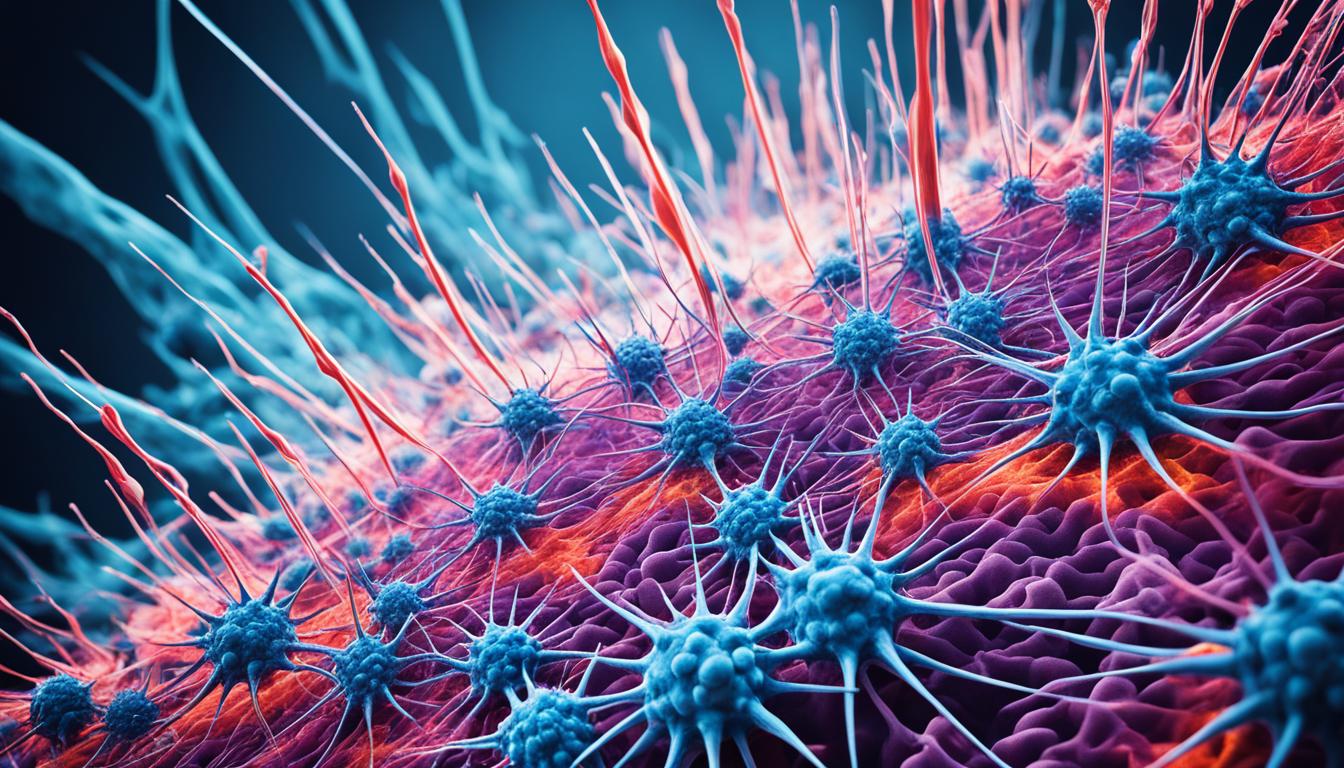Desmoplastic small round cell tumors (DSRCT) is a rare and aggressive cancer type. It typically impacts young people. The tumors form in the belly or pelvic area. They show up as clusters of harmful cells inside tough tissue.
A specific genetic change, the t(11;22)(p13;q12) chromosomal translocation, is the main cause of DSRCT. It combines the EWS and WT1 genes. Yet, scientists are still figuring out the complete cause.
The key sign of DSRCT is a lump in the stomach. This comes with stomach pain, constipation, weight loss, and a sore belly button spot. Doctors detect DSRCT through exams, biopsies, and scans like MRIs and PET scans. They also check for the cancer spreading.
DSRCT’s outlook isn’t very optimistic, with a low 5-year survival rate. Treatment options include surgery, radiation, and chemo. Stem cell therapy shows promise but is still experimental.
Key Takeaways:
- DSRCT is a rare and aggressive form of pediatric cancer.
- It primarily affects adolescents and young adults.
- Main symptoms include a solid mass in the abdomen, belly cramps, continued belly pain, constipation, unexplained weight loss, and a painful lump in the belly button.
- DSRCT is diagnosed through physical examination, biopsy, and imaging tests.
- Treatment options include surgery, radiation therapy, chemotherapy, proton therapy, high-dose chemotherapy with stem cell rescue, hyperthermic intraperitoneal chemotherapy (HIPEC), maintenance therapy, and targeted tumor ablation techniques.
DSRCT Treatment Options and Prognosis
Desmoplastic small round cell tumors (DSRCT) are aggressive and hard to treat. Yet, treatment options exist. They aim to help manage the disease. However, DSRCT often doesn’t respond well to treatment. So, the outlook for patients is usually not very good.
Surgical resection is a key treatment for DSRCT. This means doctors try to remove the tumor completely. But, complete removal might not always be possible. This is because often, the tumor is located near vital organs. Sometimes, doctors may suggest more treatments based on the patient’s case and the tumor’s specifics.
For DSRCT, radiation therapy aims to decrease the size of the tumor. It uses high-energy radiation beams. In some cases, proton therapy might be recommended. This is a more exact form of radiation therapy. It helps reduce damage to nearby healthy tissues.
Another common treatment is high-dose chemotherapy. This involves using powerful anti-cancer drugs. The goal is to kill cancer cells and make the tumor smaller. Stem cell rescue often follows. It helps the body recover by reintroducing healthy stem cells.
For tumors mainly in the belly area, there’s a special treatment called HIPEC. It involves putting heated chemotherapy drugs right into the belly. This can be more effective at targeting cancer cells.
Maintenance therapy is vital for DSRCT treatment. This means keeping up with chemotherapy or targeted therapy. The goal is to prevent the tumor from coming back. This can lead to better long-term results for the patient.
In some cases, doctors might use targeted tumor ablation. This technique aims to kill cancer cells by using heat, cold, or other methods. Which they choose depends on what’s best for the patient.
It’s important to know that there are ongoing clinical trials for DSRCT. These trials are working to find new and better treatments. They hope to enhance how we fight this difficult cancer, ultimately improving patients’ lives.
To sum up, DSRCT treatments include surgery, radiation, high-dose chemotherapy, HIPEC, and more. Unfortunately, because DSRCT is aggressive, outcomes are often poor. Yet, ongoing research and clinical trials offer hope. They aim to improve treatment and outcomes for those with the condition.
| Treatment Options | Pros | Cons |
|---|---|---|
| Traditional Radiation Therapy | – Targets cancer cells effectively – Shrink tumor size |
– Potential side effects – Limited effectiveness in DSRCT |
| Proton Therapy | – Greater precision in targeting tumors – Reduced damage to healthy tissues |
– Limited availability – Higher treatment costs |
| High-Dose Chemotherapy with Stem Cell Rescue | – Kills cancer cells – Shrinks tumor size – Supports body’s recovery |
– High toxicity potential – Risk of complications |
| Hyperthermic Intraperitoneal Chemotherapy (HIPEC) | – Concentrated delivery of chemotherapy – Enhanced cancer cell targeting |
– Complex surgical procedure – Potential side effects |
| Maintenance Therapy | – Prevents tumor relapse – Improves long-term outcomes |
– Possible side effects – Treatment duration |
| Targeted Tumor Ablation Techniques | – Destroys cancer cells effectively | – Limited suitability to specific cases – Potential complications |
Conclusion
Desmoplastic small round cell tumors (DSRCT) is a rare and aggressive cancer. It mainly affects young people. Although treatments have gotten better, the outlook for DSRCT is still not good, with a low 5-year survival rate.
The treatment options for DSRCT today are surgery, radiation, and chemo. They also include stem cell therapy and targeted tumor ablation. But, DSRCT often doesn’t get better with these treatments.
Ongoing clinical trials aim to find better ways to treat DSRCT. It’s essential for DSRCT patients to go to a sarcoma center. These centers have experts who know a lot about this type of cancer.
The current outlook for DSRCT is tough, but there is hope. Research in stem cell therapy and targeted treatments are moving forward. This gives hope that outcomes can be improved. Ultimately, better treatment options could be on the horizon for DSRCT patients.

